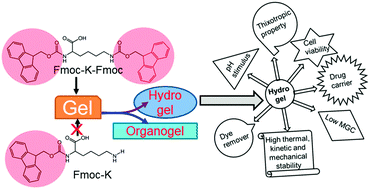An additional fluorenylmethoxycarbonyl (Fmoc) moiety in di-Fmoc-functionalized l-lysine induces pH-controlled ambidextrous gelation with significant advantages†
Abstract
In recent years, several fluorenylmethoxycarbonyl (Fmoc)-functionalized amino acids and peptides have been used to construct hydrogels, which find a wide range of applications. Although several hydrogels have been prepared from mono Fmoc-functionalized amino acids, herein, we demonstrate the importance of an additional Fmoc-moiety in the hydrogelation of double Fmoc-functionalized L-lysine [Fmoc(Nα)-L-lysine(NεFmoc)-OH, (Fmoc-K(Fmoc))] as a low molecular weight gelator (LMWG). Unlike other Fmoc-functionalized amino acid gelators, Fmoc-K(Fmoc) exhibits pH-controlled ambidextrous gelation (hydrogelation at different pH values as well as organogelation), which is significant among the gelators. Distinct fibrous morphologies were observed for Fmoc-K(Fmoc) hydrogels formed at different pH values, which are different from organogels in which Fmoc-K(Fmoc) showed bundles of long fibers. In both hydrogels and organogels, the self-assembly of Fmoc-K(Fmoc) was driven by aromatic π–π stacking and hydrogen bonding interactions, as evidenced from spectroscopic analyses. Characterization of Fmoc-K(Fmoc) gels using several biophysical methods indicates that Fmoc-K(Fmoc) has several advantages and significant importance as a LMWG. The advantages of Fmoc-K(Fmoc) include pH-controlled ambidextrous gelation, pH stimulus response, high thermal stability (∼100 °C) even at low minimum hydrogelation concentration (0.1 wt%), thixotropic property, high kinetic and mechanical stability, dye removal properties, cell viability to the selected cell type, and as a drug carrier. While single Fmoc-functionalized L-lysine amino acids failed to exhibit gelation under similar experimental conditions, the pH-controlled ambidextrous gelation of Fmoc-K(Fmoc) demonstrates the benefit of a second Fmoc moiety in inducing gelation in a LMWG. We thus strongly believe that the current findings provide a lead to construct or design various new synthetic Fmoc-based LMW organic gelators for several potential applications.


 Please wait while we load your content...
Please wait while we load your content...